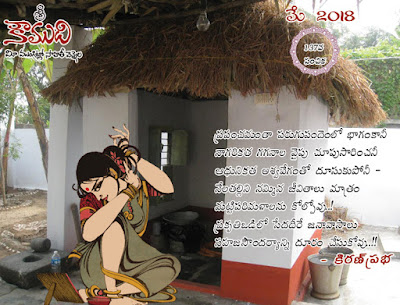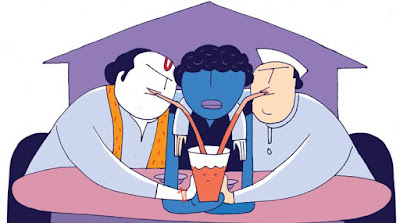Dalits are probably the most vibrant, decisive political constituency in India today. Unless these gestures go with effective action on core concerns, Dalits would regard them with as much scorn as they deserve, says Valerian Rodrigues.
Written by
Amrith Lal | Updated: May 4, 2018 7:55:19 am
It is important to understand the significance of these gestures at a time of Dalit self-assertion — whether they merely constitute a politics of optics, or have a resonance with the population they are aimed at. (Illustration: CR Sasikumar)
The BJP has asked its leaders to eat at the homes of Dalits as part of the party’s outreach to the community. The Congress had earlier highlighted Rahul Gandhi’s visits to Dalit homes, eating with the families and staying the night. It is important to understand the significance of these gestures at a time of Dalit self-assertion — whether they merely constitute a politics of optics, or have a resonance with the population they are aimed at. What is the message in the political mainstream embarking on an outreach that has communal inter-dining, an important aspect of the anti-caste politics in the early decades of the 20th century, as its central plank? Ambedkar scholar VALERIAN RODRIGUES, Ambedkar Chair at Ambedkar University Delhi, explained to AMRITH LAL the history, context and centrality of the politics of inter-dining in India’s anti-caste politics.
What is the political history of inter-dining in India?
Commensality is a much more complex problem in India than merely an attribute of caste. It is bound not just with the vegetarian-non-vegetarian divide, but also with what is regarded as vegetarian and non-vegetarian, and with whom, when and where one can eat. Initially, while one could eat kuchcha food outside of one’s caste, one could not eat pakka food. There were significant changes over time with the evolution of the public space, and its expressions such as hotels, eateries, and hostels, and with access to temple premises where food is served. Traditionally, Ramanandis, Kabirpanthis, Lingayats etc. who subscribed to egalitarianism, violated the rule of commensality. Within sub-castes, the prohibition on inter-dining has declined in many parts of the country. But the big barrier has been at the social divide where caste, class, occupation, and food habits overlap. Dalits and the majority of lower castes are non-vegetarians, if they have a choice.
During the early 20th century, alongside the complex nationalist churning, inter-dining came to be promoted in several places, particularly in working class solidarities. But it never became a larger expression of sociality in India. The Congress under Gandhian aegis turned definitively vegetarian.
How significant is the symbolism of an upper caste leader of a non-Dalit party eating at a Dalit home?
Eating in common the same food cooked by members of a community in common vessels and served in common plates has been an expression of community bonds in many parts of India. The rebellion against social codes was manifested in the violation of the injunctions that forbade a member from eating outside. While an upper caste leader eating in Dalit homes might symbolically express that he is prepared to be included in their community bond, the instrumental use of such gestures is very obvious to everyone, including to Dalits.
Inter-dining was important in the anti-caste politics of the last century. Post-Ambedkar, post-Mandal, does it retain the same progressive pull for Dalits?
Dalits have far more serious concerns — atrocities, social exclusion, marginality, food, education, employment, housing, representation and dignity — to worry about than inter-dining. Inter-dining as a regular practice involving families and castes which were hitherto non-commensal may help in reinforcing community bonds if it goes alongside one or more of the above concerns. Even in cases of inter-dining, the real test would be if Dalits ate alongside the upper castes, and were invited to do so in the houses of the upper castes, as Minister Uma Bharti has suggested. The available data suggest it is very uncommon for upper-caste urban middle- class society in India to reach out to Dalit urban middle classes in common dining in their houses.
So are food and dining still markers of caste purity and hierarchy in the Hindu social order?
As mentioned earlier, these markers were challenged by social reformers, and renunciatory sects did not adhere to them wholly. The national movement in India, and particularly Dr B R Ambedkar, put this issue up front, although he thought that taboos of inter-dining are profoundly caught with the ideology that governs practices of caste and untouchability. There is an expansive public today that may not practise many of the taboos that inform eating and drinking. But it does not mean that the normative values governing such practices have undergone much change. Some spaces such as the interiors of the house, dining with families, and appreciating culinary diversity, remain very uncommon.
Can it be said then, that in an era in which Dalit politics is focussed on rights and self-respect, a politics of gestures is unlikely to yield political dividend?
Rights and self-respect are strongly caught with community practices. While politics of gestures may not hold the key to Dalit sensibilities, the prohibition of commensality, and in the way it is practised towards Dalits, is an affront to their dignity and associated rights.
How then should non-Dalit parties seek to address Dalit concerns?
I have mentioned above some of the most important concerns before Dalits today. Eventually, every party is going to be judged on the basis of its sensitivity towards these concerns. Dalits are probably the most vibrant and decisive political constituency in India today. If gestures go along with effective action on core concerns, well and good. Otherwise, Dalits would regard the gestures with as much scorn as they deserve.
Source:
indianexpress



